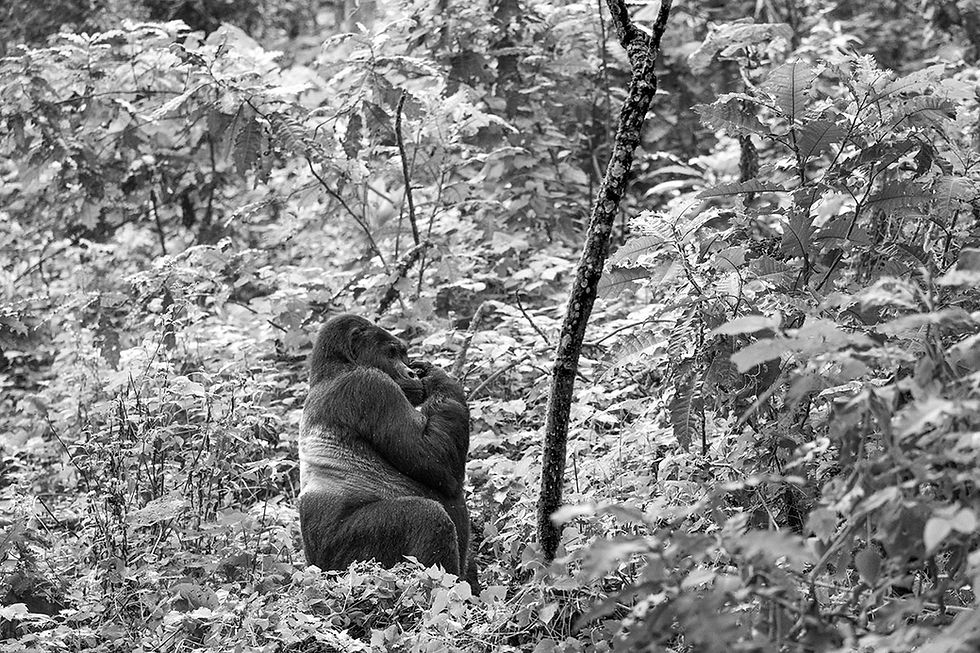What to Think About When Photographing Gorillas
- Johan Siggesson

- Jul 20
- 4 min read
Photographing gorillas is one of the most personal wildlife experiences I’ve had. It’s quiet. It’s close. And it stays with you. These aren’t animals you watch from a distance in a vehicle across the savanna. You meet them deep in the forest, on their terms and in their space.
Before I even lifted the camera, I felt it. There’s something about being near a gorilla that changes how you move, how you breathe, and how you look at the moment. If you ever find yourself lucky enough to be there, here are a few things to keep in mind.
Respect Comes First
This isn’t just another sighting. Photographing gorillas comes with responsibility. These animals are strong, intelligent, and deeply social. The rules your guides give you about distance, movement, and silence exist for a reason.
But it’s not just about safety. It's about trust. When you're calm and respectful, the experience becomes more natural. The gorillas are intelligent and will notice.
So does your camera...
Light in the Forest Isn’t Easy
The light in the forest can be tough. It’s often dim, and when the sun does break through the trees, it comes in hard and uneven. You’ll be working with a mix of bright spots and deep shadow. Expect to shoot at high ISO.
This makes exposure a challenge. Bright areas can blow out fast, while the shadows lose detail. I usually expose for the highlights and try to recover the shadows later. It’s easier to bring back shadows (although introducing noise) than it is to fix lost detail in bright spots.
A wide aperture helps in low light, but it also narrows your depth of field. If a gorilla is close, even a small movement can shift focus off the eyes. I take my time and try to hold steady. Tip: If you need extra stability, rest your camera or lens gently against a nearby tree. It works almost like a tripod and can make a big difference when you’re dealing with low light and slower shutter speeds. It’s a simple trick, but it helps keep things steady without carrying extra gear.
If you like to experiment, low light in the forest can be a good time to try some intentional camera movement (ICM). The slower shutter speeds work in your favour and allow for a bit of creative play. It won’t suit every situation, but now and then, a bit of blur can say more than a sharp frame. It can add mood and bring out something softer and more emotional in the scene.

Keep It Simple and Honest when photographing gorillas
Like in most photography, it’s the story in the image that matters most. It helps when everything is technically right such as sharpness, focus, and exposure. But that alone is not enough. A flawless image without any emotion rarely connects. What stays with people is the feeling in the frame, not just the detail. This is especially true when photographing gorillas. So much of what they do feels familiar. The way they sit, the way they interact, the way they watch you. Their gestures and behaviour often remind us of ourselves. That emotional connection is often what draws people in. Remember: A standard gorilla permit gives you just one hour with the gorillas. It goes by quickly, so make the most of it. Stay present, take your time, and be ready for whatever the moment brings.
Stay Low and Don’t Rush
If you can, get down to their level. Eye-level images feel more personal. You’re not looking down at them, you’re meeting them where they are.
If a gorilla looks at you, don’t react too quickly. Breathe. Let the moment settle. Then, when it feels right, raise your camera slowly and quietly. Some of the strongest images come when nothing dramatic is happening.
Don’t forget: Avoid eye contact with gorillas, especially silverbacks. A direct stare can be seen as a threat or a challenge and may make them feel uncomfortable or defensive.
Include the Forest
Portraits are powerful, but don’t forget where they live. The forest matters. It’s part of who they are.
Pull back now and then. Show the vines, the trees, the layers of green. A silverback framed by foliage or a youngster climbing through the branches tells a bigger story. These aren’t studio portraits. They belong to a very specific place. Let that place show.

Be Present
It’s easy to stay locked into the camera, chasing frames. But take a few minutes to just be there. Watch how they move. Listen to the noises. Take in the moment without trying to capture it.
Most images are stronger when they’re not rushed. And when you do go back to the camera, you’ll shoot from a clearer place.
Final Thoughts
Photographing gorillas isn’t about ticking a box or trying to take as many photos as possible. For most people, it’s a once-in-a-lifetime experience. You usually get one hour with them. Maybe two, if you’re lucky. That’s very different from a typical safari, where you can return to a sighting or area again and again, perhaps over a week or two.
There’s no time to ease into it or hope for a better moment later. You step into their world for a short while and then you’re done. That’s why it’s important to find a balance. Photograph the moment, but also take the time to simply watch and take it in.
Conclusion: You’ll want to remember how your gorilla-experience felt and not only what it looked like.


